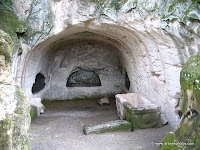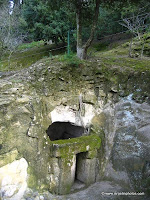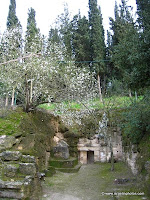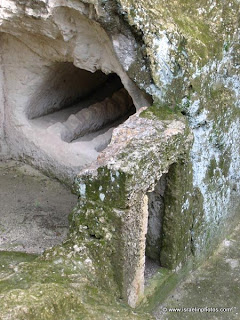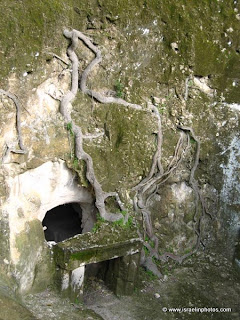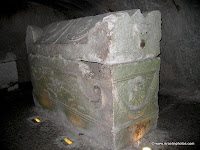The Necropolis of Beit She’arim, with catacomb of Rabbi Yehuda Hanasi
A necropolis is a large cemetery or burying-place (from Greek: nekropolis “city of the dead”).
The town of Beit She’arim was built on a low hill in the western part of Lower Galilee, and flourished from the second through the fourth centuries CE.
Josephus Flavius wrote ( Life 118-119) that Beit She’arim (in Greek: Besara) was the central village of an agricultural estate belonging to Berenice (b. 28) the daughter of King Herod Agrippa I of Judea and great-granddaughter of Herod the Great. It was customary action for royal estates to become the personal property of a conquering monarch.
After the Great Jewish Revolt (66-73CE)this territory would have come into possession of the Roman emperor.
Rabbi Judah HaNasi (c.135-220 CE), or more accurately in Hebrew, Rabbi Yehuda HaNasi (also known simply as Rabbi), who was the spiritual authority of the time, had strong ties to the Roman authorities, who in turn supported his position in the community.
His friend the emperor Marcus Aurelius Antonius (121-180 CE) gave him gifts included property in Beit She’arim.
In Rabbi Yehuda’s time Jews were undergoing harsh persecutions and many feared that the Oral tradition would be forgotten. He decided to write the Oral tradition in a desperate attempt to preserve the chain of tradition, one of the most important pillars of Judaism. Rabbi Yehuda HaNasi was known as the compiler of the "Mishna". He moved the "Sanhedrin" (council of seventy-one Jewish sages), who constituted the supreme court and legislative body of Ancient Israel and his own study hall to Beit She’arim.
Beit She’arim became an important spiritual center. Because of health reasons Rabbi Yehuda lived the last seventeen years of his life in Sepphoris and the Sanhedrin went with him.
When he died in the year 220 CE, Rabbi Yehuda Hanasi was buried in the catacombs carved inside the limestone necropolis of Beit She’arim.
Jews had always wished to be buried on Mount of Olives where the Messiah was expected to appear, but in 135 CE Hadrian closed the area round Jerusalem to Jews, what made this desire impossible.
The Beit She’arim necropolis became the most important for Jews of Israel and the Diaspora during the Mishnaic and Talmudic periods.
The main industry of Beit She’arim became work for the dead; quarriers, stonecutters and sculptors were permanent active. The glory of Beit She’arim was snuffed out in 352CE when Gallus Caesar destroyed the town in an attempt to cow the rebellious Jews.
Excavations revealed the ancient city of Beit She’arim and more than 30 caves were excavated. The entrance to every cave has an impressive fa?ade designed in the classical style.

